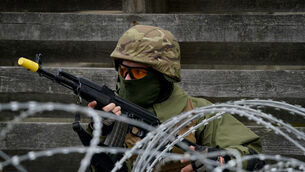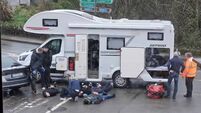Tsunami disaster death toll soars
Two weeks after a tsunami slammed into coastlines around the Indian Ocean, thousands of bodies were still being pulled out of the mud and world leaders visiting the region were shocked at the devastation.
“I have never seen such utter destruction mile after mile,” UN Secretary General Kofi Annan sombrely told reporters after a helicopter flight yesterday over the western coast of Indonesia’s Sumatra island. “You wonder where are the people? What has happened to them?”
Indonesia said searchers found 7,118 more bodies in the shattered coastal town of Meulaboh, where families picked through piles of rubble. Indian officials raised that country’s toll by 310, most of them killed in the Andaman and Nicobar islands, where 5,600 were missing and presumed dead.
These increases raised the death toll across Asia and Africa from the December 26 disaster to 147,000. Foreign Secretary Jack Straw, visiting the Thai resort island of Phuket, said the number of British tourists killed will likely more than double to 440.
As the death toll soared, so too did the lists of missing. Sri Lanka, with more than 30,000 known dead, added 528 names to its ranks of missing, for a total of 4,984.
Indonesia, the worst hit country, estimates 101,318 dead and 10,070 missing.
Officials said some people trying to find loved ones were only now reporting them as missing. “First the people tried to find them among the dead, then went around the hospitals. Now they are coming to us,” said K.G. Wijesiri at Sri Lanka’s National Disaster Management Centre.
The jump in figures came a day after a top UN official predicted the final toll would be far higher, with scores of bodies swept out to sea by the killer waves.
“The scale and magnitude of this disaster makes it literally unique and ... bodies are still being washed up and unearthed,” Straw told reporters while touring stricken areas in Thailand. “The scale of the effort still required is truly daunting.”
Governments, led by Australia and Germany, have pledged nearly 4 billion dollars (£2.2 billion) in aid – the biggest ever relief package.
The world’s richest nations have also agreed that debt repayments for tsunami-devastated countries should be frozen.
The seven leading industrial nations, or G-7, will seek agreement from all creditors at the next meeting of the Paris Club on Wednesday.
US Secretary of State Colin Powell toured stricken areas in Sri Lanka and promised long-term American help to rebuild.
“Only by seeing it on the ground can you really appreciate what it must have been like on that terrible day,” he said.
One after another, communities well-rooted for generations were obliterated in moments in Sumatra. Most substantial structures were reduced to bleached concrete pads. From the air, nothing was visible of flimsier village houses except for scattered corrugated iron roofs crumpled like paper.
Pilots and crewmen returning to the USS Abraham Lincoln after seven hours of non-stop flying struggled to find words to describe the scale of the devastation.
“You can’t really explain. There used to be towns and cities there. All the people once had homes, lives,” said Petty Officer 1st Class Scott Wickland, of Cumberland, Wisconsin. “Now there is nothing.”














